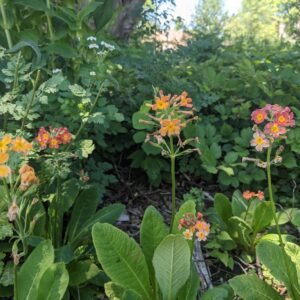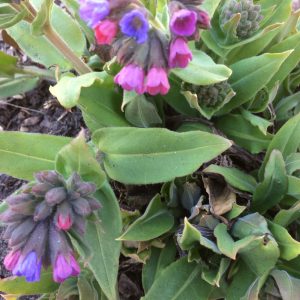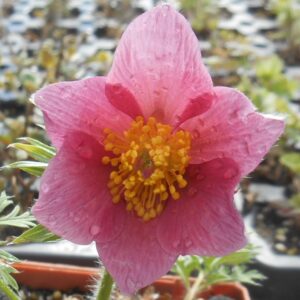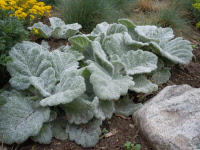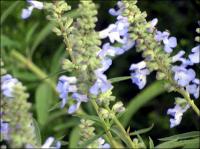Deer Resistant Plants
Showing 113–120 of 155 results
-
Primula x bulleesiana Candelabra primrose Z 4-7
Blooms June-July, a rainbow of colors ranging from red, orange, rose, to cream, lavender and purple
OUT OF STOCK
Blooms June-July, a rainbow of colors ranging from red, orange, rose, to cream, lavender, and purple
Size: 18-24” x 12-18”
Care: Sun to part shade in moist to wet well-drained soil
Wildlife Value: Attracts butterflies. Deer resistant
Awards: Royal Horticultural Society Award of Garden Merit 1993Hybrid cross between Primula bulleyana and Primula beesiana (both parents are native to the Himalayas and China).
Collected in China, introduced to Britain in 1906 -
Pulmonaria angustifolia Narrow-leaf lungwort, Blue cowslip Z 4-8
One of the earliest to flower - Pink turning azure blue, trumpet-shaped flowers in April- May. Fuzzy foliage.
One of the earliest to flower – Pink turning azure blue, trumpet-shaped flowers in April- May. Fuzzy foliage.
Size: 12”x 18”
Care: full to part shade in moist to moist well-drained soil.
Native: Austria & Hungary.
Wildlife Value: walnut tolerant and deer resistant. Early source of nectar for bees.
Awards: Royal Horticultural Society Award of Garden MeritAngustifolia means “narrow leaves.” But its leaves are only narrow compared to the leaves of other Pulmonarias.
Grown in gardens before 1590’s.
-
Pulmonaria saccharata ‘Mrs. Moon’ Greater lungwort, Bethlehem sage Z 3-8
In early spring funnel form pink flowers turn to blue above bristly, white mottled green foliage. Leaves attractive through fall
OUT OF STOCK
In earliest spring funnel form pink flowers turn to blue above bristly, white mottled green foliage. Leaves attractive through fall
Size: 8-18” x 18-24”
Care: full to part shade in moist well-drained soil
Native: species France & Italy
Wildlife Value: walnut and deer tolerant. Early source of nectar for bees.The species originally described by English botanist and gardener to Queen Mary, Leonard Plukenet (1641-1706) .Described by Philip Miller (1768) as having “spotted leaves as if they were incrusted with sugar.” ‘Mrs. Moon’ cultivar offered for sale in 1938 by Gardenside Nurseries in Shelburne VT. Name Pulmonaria from Latin pulmo or lung (e.g.today’s pulmonary) because the blotched leaves were considered to resemble lung disease. Saccharata comes from Latin word for sugar because the white bristly leaves resembled sugar coating.
-
Pulsatilla vulgaris var. rubra syn. Anemone pulsatilla var. rubra Pasqueflower
Wine-red petals of bell-shape with yellow centers flowers in early spring. Fun, furry foliage
OUT OF STOCK
Wine-red petals of bell-shape with yellow centers flowers in early spring. Fun, furry foliage and Medusa-like seed heads.
Size: 12-20” x 4-8”
Care: sun in well-drained to moist well-drained soil
Native: Europe
Wildlife Value: Deer resistant, early pollen source for bees.Called Pasqueflower because it blooms at Easter time. Variety rubra considered a separate species, not a variety, by Caspar Bauhin in Theatri botanici, 1671. Illustrated in Gerard’s Herball, 1636.
-
Pycanthemum muticum Clustered Mountain Mint, Blunt Mountain Mint Z 4-8
Silvery bracts underlying silvery-pink pincushion flowers blooming from June to September. Flowers and leaves minty fragrance.
OUT OF STOCK
Silvery bracts underlying silvery-pink pincushion flowers blooming from June to September. Flowers and leaves minty fragrance.
Size: 12-36” x 12-36” spreading.
Care: sun to part shade in moist to well-drained soil incl. drought
Native: Maine to Michigan, south and angling southwest from Illinois to Texas
Wildlife Value: Deer resistant. One of highest nectar and pollen producing flowers attracting copious numbers and kinds of bees, butterflies, wasps and other insects.
Awards: Georgia Native Plant Society Plant of the Year 2022Collected and described by French botanist André Michaux (1746-1802) who spent 11 years exploring the North America for plants. 1800.
-
Rudbeckia subtomentosa ‘Henry Eilers’ Z 4-8
These Rudbeckias tower above basal leaves on rigid, branching stems forming clumps of sun yellow petaled flowers surrounding a raised, brown dome of disc flowers. But instead of flat petals, the petals are rolled into narrow tubes, looking like many spokes of a wheel blooming from mid-summer into fall.
OUT OF STOCK
These Rudbeckias tower above basal leaves on rigid, branching stems forming clumps of sun yellow petaled flowers surrounding a raised, brown dome of disc flowers. But instead of flat petals, the petals are rolled into narrow tubes, looking like many spokes of a wheel blooming from mid-summer into fall.
Size: 3-5’ x 1-2’
Care: sun in moist well-drained soil
Wildlife Value: attracts butterflies, deer resistantHenry Eilers discovered this cultivar while scouting a southern Illinois prairie. Here’s his story.
Henry Eilers, born in 1934, long-time nurseryman, had introduced selections of different ornamental plants that he found growing at his nursery. But Rudbeckia subtomentosa ‘Henry Eilers’ is different. Henry worked tirelessly for decades to preserve Illinois plants and their diversity. In the early 1980’s while scouting a prairie remnant near Witt in Montgomery County IL he spied a small clump of uncommon Black-eyed susan. Instead of the usual broad, flat petals, this one has narrow, quilled petals. He dug it and replanted it at his nursery where it grew on. It still grows in his wildflower garden. He decided to name it Rudbeckia ‘Montgomery County.’ In the 1990’s Henry took it and other native wildflowers to a native plant sale at the Shaw Arboretum, Missouri Botanic Garden. He and another nurseryman, Larry Lowman exchanged a few plants, one being this Rudbeckia. Several years later he found it for sale in the Plant Delight’s Nursery catalog, renamed Rudbeckia ‘Henry Eilers.’ Over time the plant appeared in gardening magazines and mail order catalogs. It now grows in the entrance planting at the National Botanic Garden in Washington, at the Missouri Botanic Garden and the Brooklyn Botanic Garden. A nurseryman from the Check Republic told Henry he had been growing it! -
Salvia argentea Silver sage Biennial or short lived perennial Z 5-7
Large rosettes of the woolliest silver leaves. So soft you want to pet them. This one’s for the leaves, not the flowers. It dies after flowering so cut back flower stems to prevent flowering, or, if you want to save seeds let it flower.
Large rosettes of the woolliest silver leaves. So soft you want to pet them. This one’s for the leaves, not the flowers. It dies after flowering so cut back flower stems to prevent flowering, or, if you want to save seeds let it flower. It self-seeds sometimes.
LIMITED QUANTITIES AVAILABLE, LIMIT OF 1 PER CUSTOMER.
Size: 2-4’ x 12"
Care: Sun in well-drained soil.
Native: Europe & No. Africa around Mediterranean
Awards: Royal Horticultural Society Award of Garden Merit; Plant Select® Central Rocky Mountain regionSalvia is from the Latin “salveo” meaning “to heal” referring to the plant’s ancient medicinal uses. Collected before 1750. The Garden reported it was introduced in 1768. Liberty Hyde Bailey said its, “white woolly foliage makes it a very decorative plant.” (1933).
-
Salvia azurea ‘Grandiflora’ Blue sage, Prairie sage Z 5-9
August – October sky blue racemes. One of internationally known garden designer Piet Oudolf’s 100 “MUST HAVE” plants, Gardens Illustrated 94 (2013)
August – October sky blue racemes. One of internationally known garden designer Piet Oudolf’s 100 “MUST HAVE” plants, Gardens Illustrated 94 (2013)
Size: 4’ x 24-36”
Care: Sun, moist well-drained soil
Native: MI to e. NE, s. AR & TX, Wisconsin native
Wildlife Value: Primarily long tongued bees such as Bumble bees visit and pollinate the plants. Host for caterpillars of Hermit Sphinx butterflyNative Americans roast or popped the seed of Blue sage as a grain. American garden cultivation since 1700’s. William Robinson, father of the mixed perennial border, praised the Blue sage as “one of the finest (perennials from North America) in its flowers, borne as dense spikes of a beautiful pale blue during September and October.”

